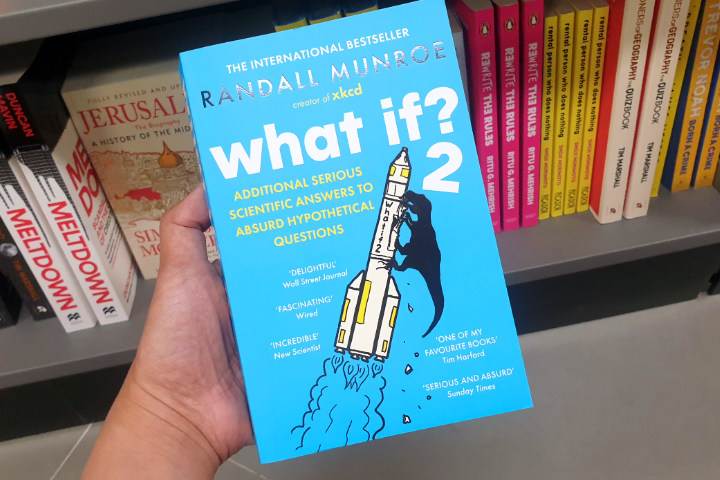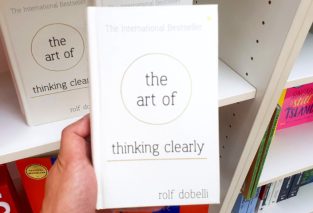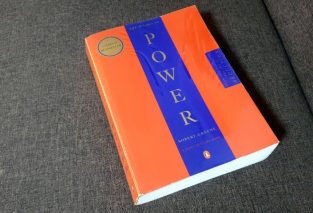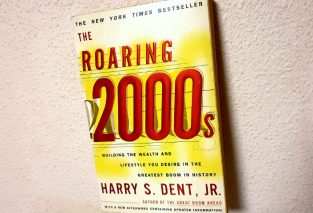A book that explores quirky hypothetical questions answered with science and humor. Dives into imaginative scenarios, combining curiosity with scientific explanations, revealing surprising insights about the world and universe.

In What If? 2, Randall Munroe takes readers on an exhilarating, thought-provoking ride through the realm of the scientifically impossible. Yet somehow, astonishingly plausible.
A follow-up to his immensely successful predecessor What If?, this book is a delightful cocktail of curiosity, humor, and nerdy charm.
Munroe, the former NASA roboticist turned internet sensation, continues to use his sharp wit and deep knowledge of physics to answer the kinds of outlandish questions that many people might only ask after a few too many drinks.
He is the creator of xkcd.
Some of the most bizarre, yet fascinating hypothetical questions are found in the book.
What makes this collection of hypothetical questions so engaging is the way the influencer combines rigorous scientific explanation with an irreverent, almost comic-book-like tone.
The result is an utterly unique experience that both entertains and educates, delivering high levels of both intellectual and emotional satisfaction.
The book is structured around the concept of answering absurd questions with a surprisingly detailed level of scientific accuracy.
These aren’t just idle musings.
The collection of answers is a testament to the joy of inquiry, where each question opens a portal into the realm of possibilities that straddle the line between imagination and reality.
Each chapter of the book presents a seemingly ridiculous scenario. These inquiries, ranging from the impossibly hypothetical to the downright silly, are dissected with a precision that reveals the underlying science in a way that is both accessible and engaging.
They pretty much go along the lines of his viral post on what would happen if you tried to hit a baseball pitched at 90% the speed of light. This is asked with a seriousness that belies their absurdity, mind you. And then Munroe methodically works through the problem with calculations, theories, and the occasional leap of logic.
It’s like watching a mathematician stretch the laws of physics to their very limits while simultaneously cracking a joke every few pages.
Take, for instance, a question about how much rubber from tires cover the road. Munroe dives into not just the rubber loss rates but also the logistics of how high roads would rise in a year.
He brings real-world applications into the fantastical scenarios, but at the same time, he’s quick to remind us of the limits of science, leaving us to ponder, “Would this really work?” while trying not to laugh at how absurdly impossible the scenario is.
What stands out most in the writing style is the ability to blend pure logic with creativity.
It takes problems that seem totally disconnected from reality and provides an unexpected, almost absurdly logical solution.
For instance, in one section, Munroe explores how far a massive eyeball the size of Earth would see. Naturally, this would involve some very unusual things to think about, and Munroe dives into everything from the amount of liquid a teardrop would contain and how far it could see depended on turbulence.
He doesn’t just stop at the easy answers but goes deep, constructing a world where we understand the physics and chemistry, yet find ourselves in awe of how such an action could unravel the fabric of space-time itself.
The underlying theme of What If? 2 is not so much about providing definitive answers as it is about encouraging the reader to engage with the wonder of exploring the unknown. It invites us to take seriously the potential of seemingly impossible scenarios and consider the fascinating consequences, no matter how ridiculous they might sound.
It’s like getting an uninvited glimpse into the workings of the universe, and here is our quirky tour guide.
The humor, however, is as important to the book as the science.
It is charmingly sarcastic, often slipping in puns and playful asides that prevent the science from becoming overwhelming.
In one section, he humorously explains how launching an airplane with catapults would work, and then casually adds, “If it
could keep helping you during the climb, it wouldn’t be a catapult, it would
be an escalator”.
This ability to inject humor into complex topics is where What If? 2 truly shines. It breaks down incredibly difficult scientific ideas into bite-sized chunks, all the while ensuring that readers are entertained.
There’s something beautifully infectious about this approach, as it makes the book feel less like a lecture and more like a conversation with a friend who just happens to be a genius.
Throughout “What If? 2,” Munroe weaves together threads of physics, biology, engineering, and even philosophy. This journey through hypothetical scenarios serves as a reminder that science is not just a tool for understanding the world but also a lens through which we can view the infinite tapestry of what might be possible.
Shortcomings
There are moments when the irreverent humor, while delightful, can feel a bit too glib.
It’s as if it’s more concerned with being funny than fully exploring the complexities of some of the more intriguing scenarios.
In several chapters, the scientific explanations feel rushed or glossed over in favor of getting to the punchline. While this doesn’t detract from the overall enjoyment of the book, it does leave one wondering whether more in-depth analysis could have been provided.
And in some instances, the witty banter might leave readers wanting a deeper dive into the mechanics behind the hilariously hypothetical situations.
Some answers, constrained by brevity, may gloss over the intricacies that would intrigue more scientifically inclined readers. A potential improvement could be the inclusion of references or suggested readings for those eager to explore further. Maybe an appendix of sorts that guides the inquisitive reader beyond the playfulness and to more finite explanations.
Another thing I’ve noted is the occasionally repetitive nature of the questions.
While some of the scenarios feel fresh and original, a few of the later questions begin to feel like rehashes of earlier material.
There’s a limit to how many times you can ask, “What if?” and come up with a completely new and mind-blowing answer.
While Munroe’s talent for making seemingly trivial questions endlessly entertaining is impressive, after a while, some of the novelty starts to wear off.
Perhaps the book could have benefited from a broader range of questions, extending into topics like the future of technology or the consequences of current scientific breakthroughs, which would have added some variety and deeper relevance.
Biggest Takeaway
Perhaps the biggest is how it challenges our understanding of what’s possible.
It’s a book that makes the impossible feel real and brings the wonders of physics to a wide audience.
And yet, it also invites a larger question of how much do we really understand about the universe we live in?
It’s easy to become bogged down in the minutiae of life and forget that the universe operates on a scale far beyond our daily concerns.
The outlandish scenarios remind us that, at its core, science is about questioning everything, no matter how preposterous the question might seem.
For all its quirks, the book serves as a reminder that, sometimes, the most profound answers come not from the questions we know to ask, but from those we’re too afraid to imagine.
It urges us to engage with the unknown and have fun with it, to explore the world through curiosity rather than fear.
Every question holds value and potential for discovery.
In answering bizarre questions like, “Could a person eat a whole cloud?”, the author doesn’t just reveal scientific truths. He taps into something more profound. Our fundamental drive to understand and discover, to find joy in the pursuit of knowledge itself.




